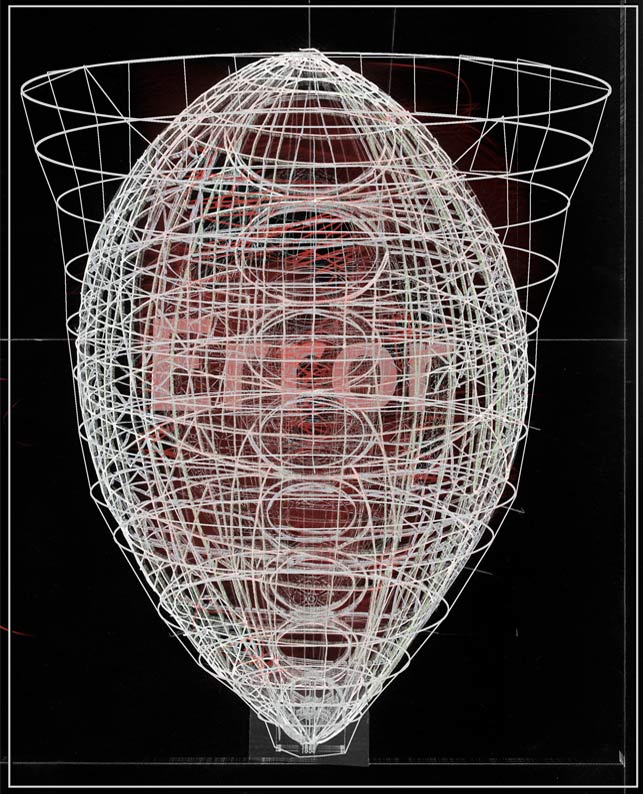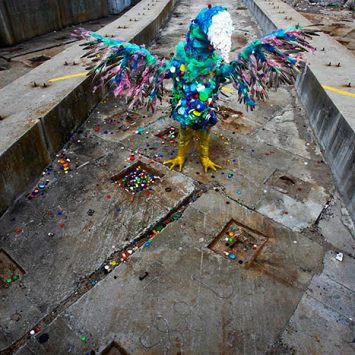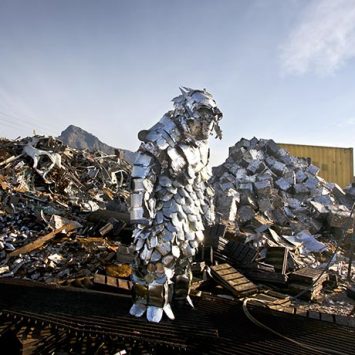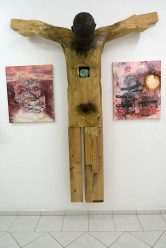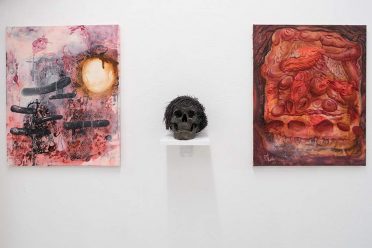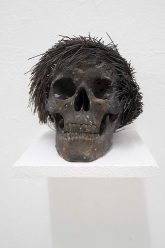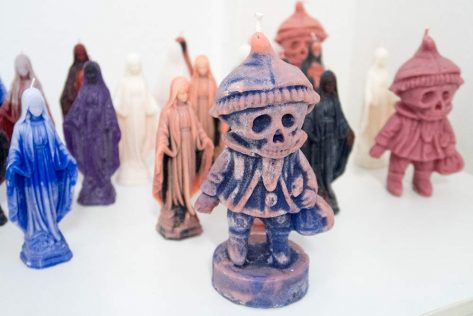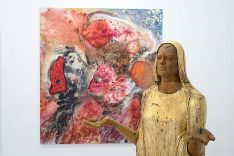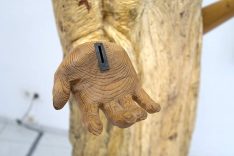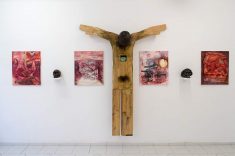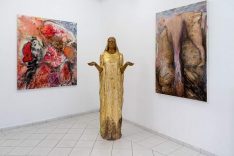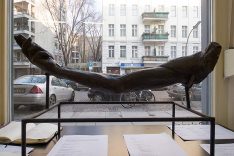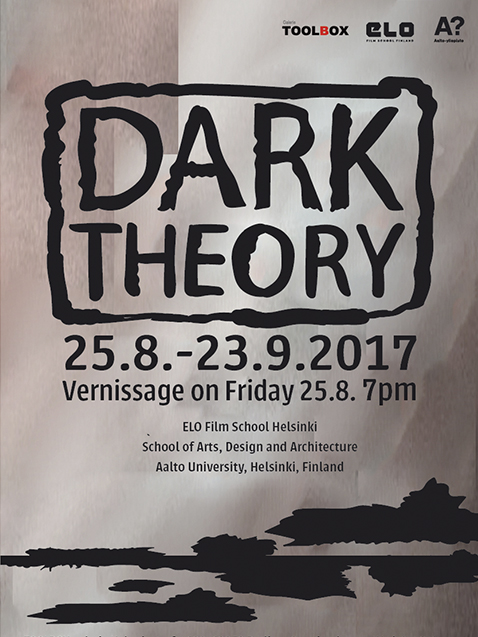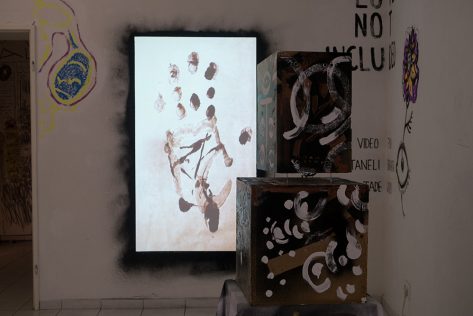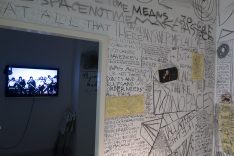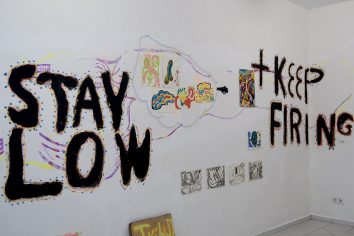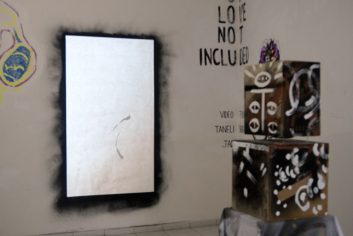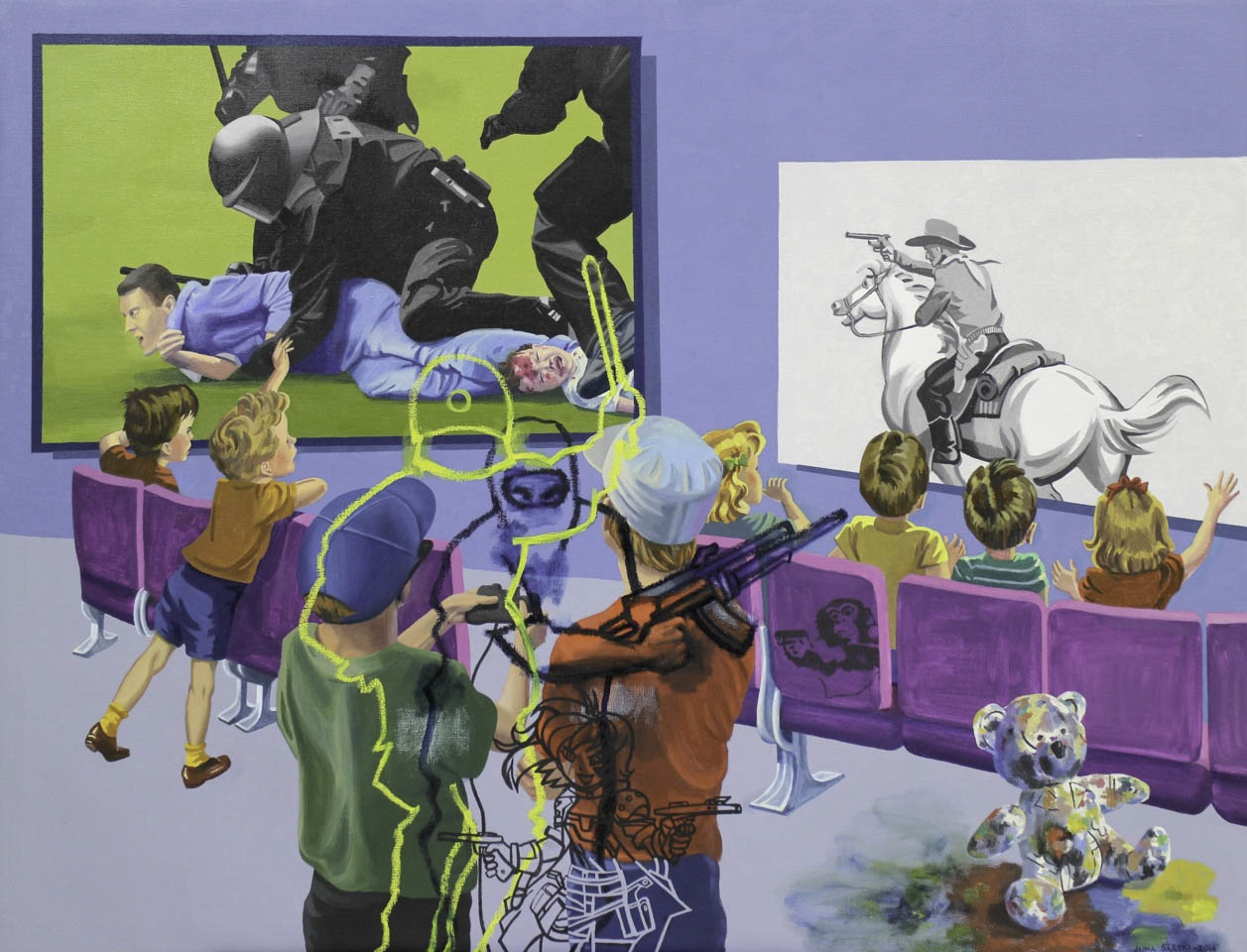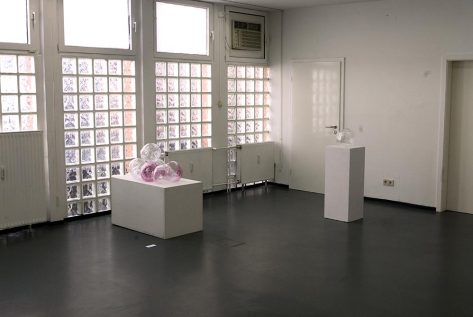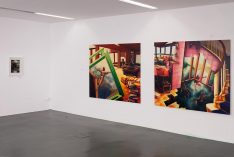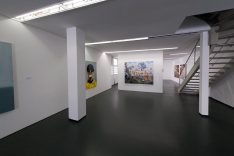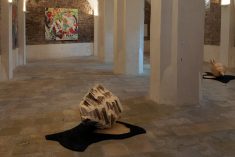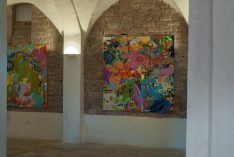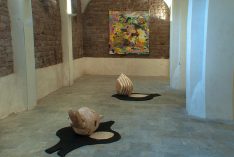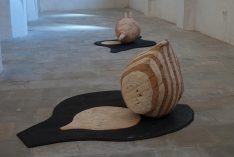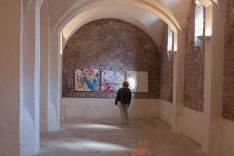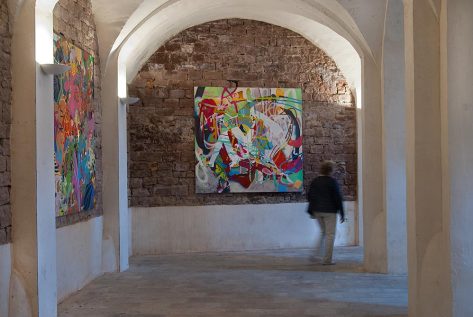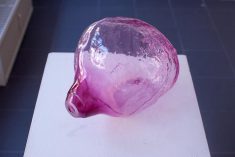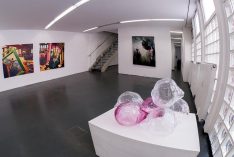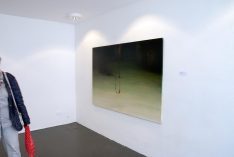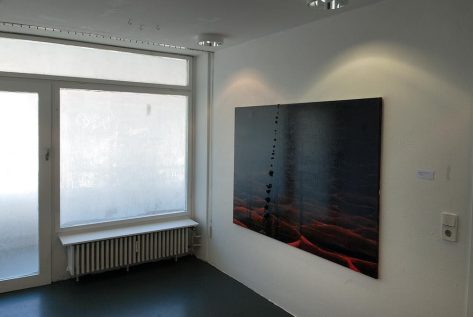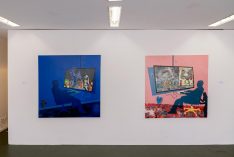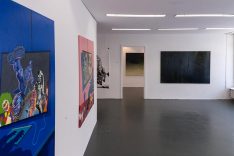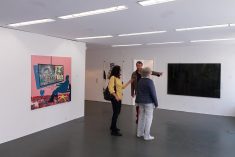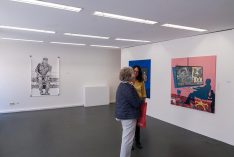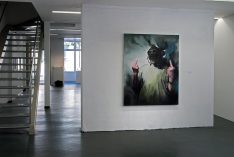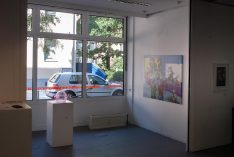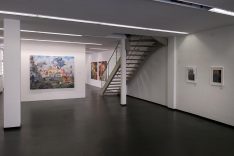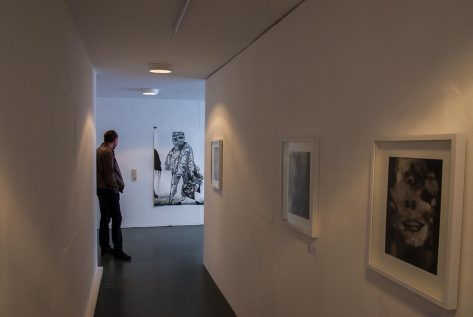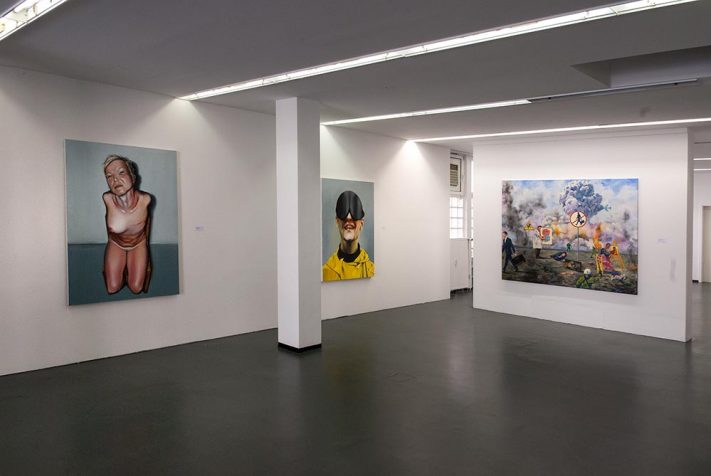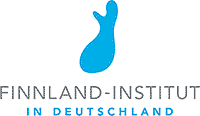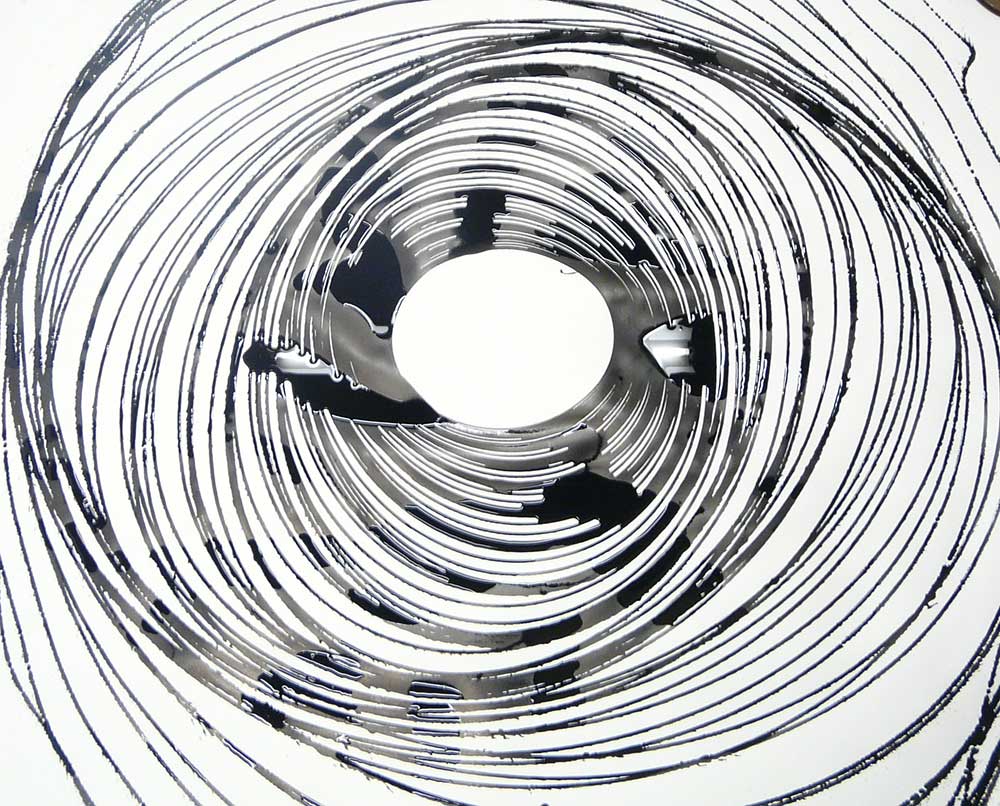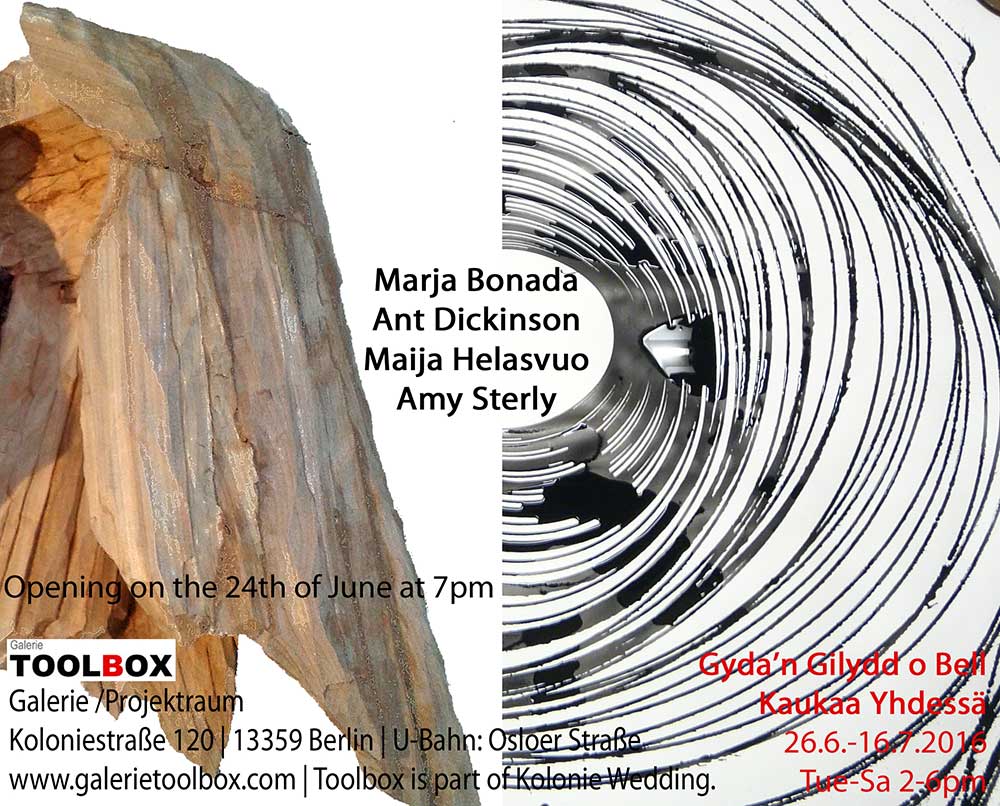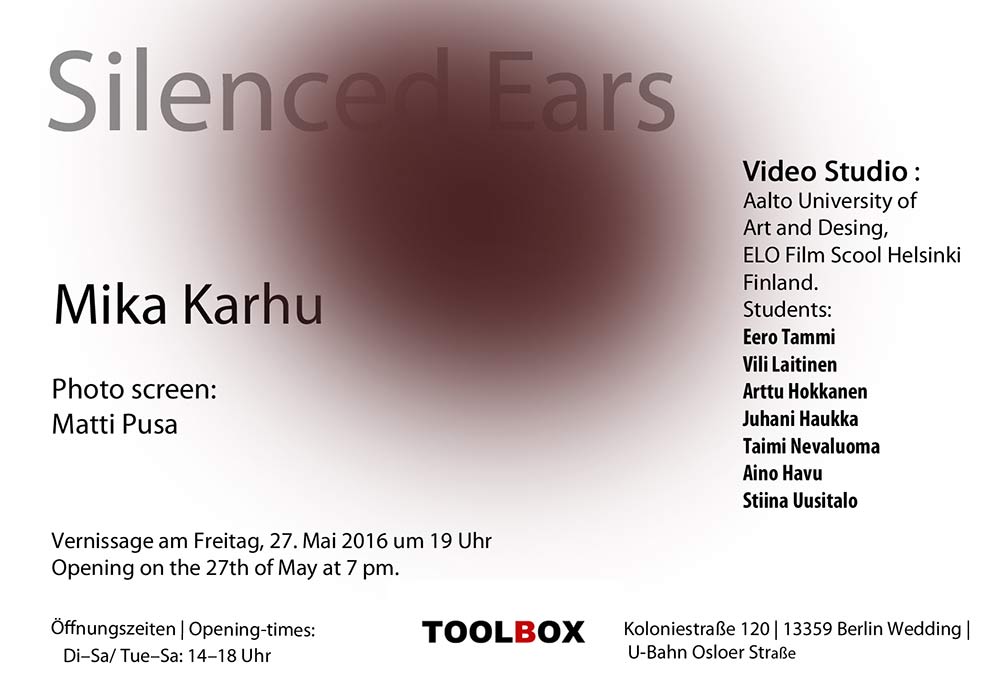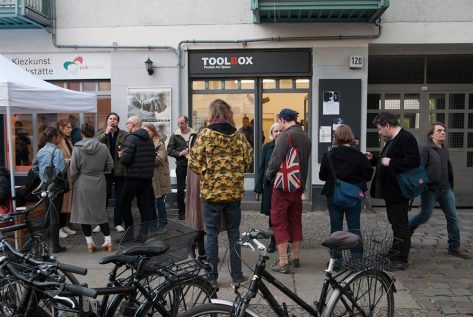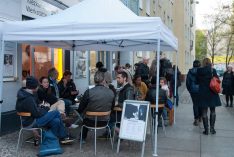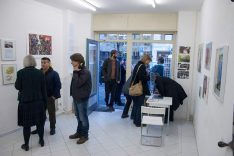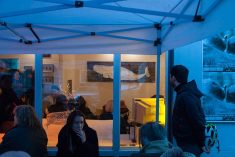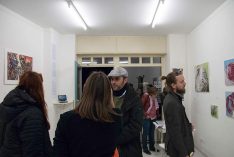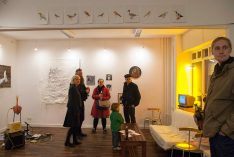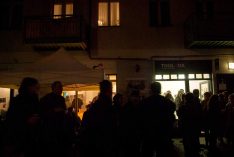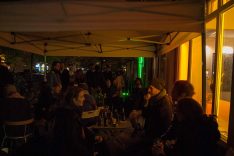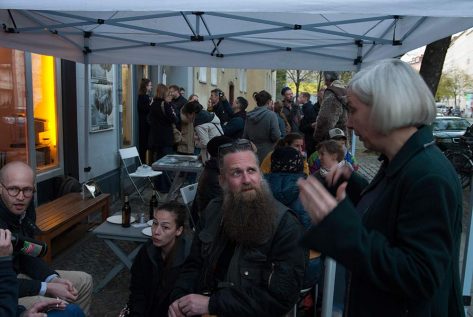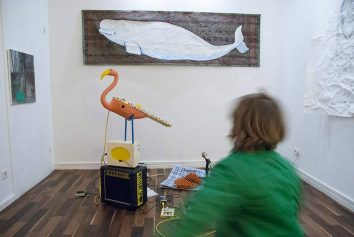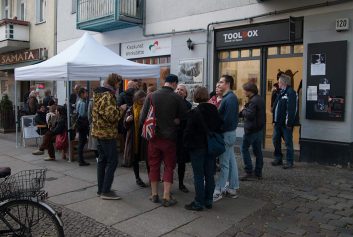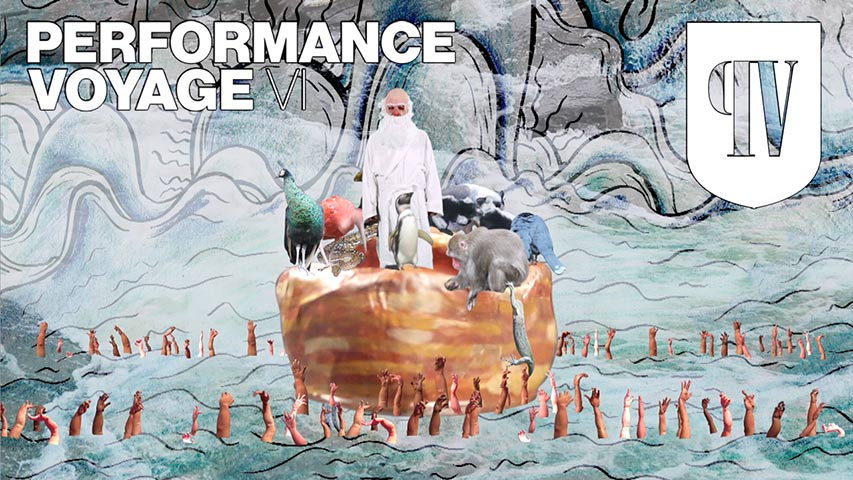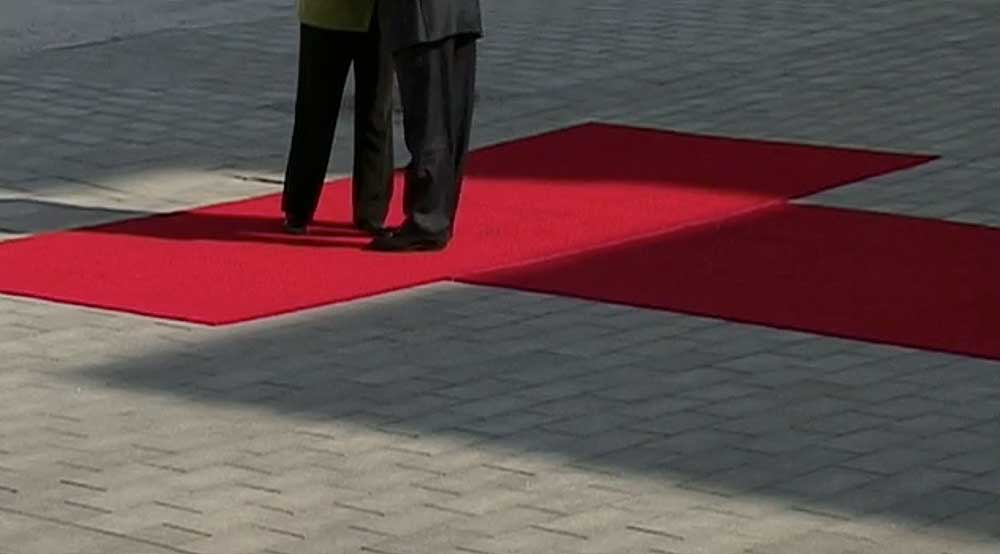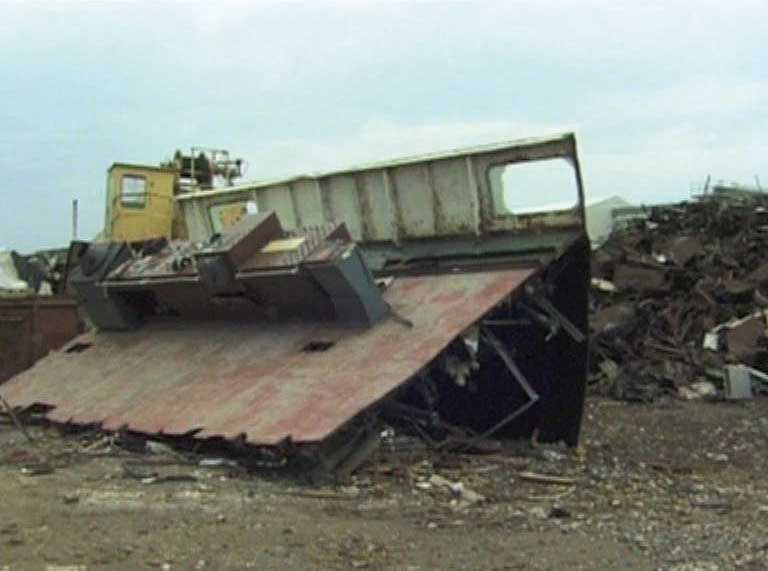Menagerie – Tiere im Zoo der Kunst | Animals in the Art Zoo |
Text in English
Quotes from Artists | Zitate
Dear friends and artists,
we would like to invite you to the Finissage of our exhibition
Menagerie – Animals in the Art Zoo
Friday, May 20th
Toolbox and madeinwedding are showing two parts of the exhibition.
- madeinwedding is open from 2–6 pm
- Toolbox is open from 2 pm–open end
If you want to see the whole exhibition you can do so between 2–6 pm.
At 7 pm small buffet (food) from Mr. Ira Schneider and drinks will be served.
Toolbox – Finnisch-Deutscher Projektraum, Koloniestraße 120
in Kooperation mit Madeinwedding
Vernissage: Freitag 29. April um 19 Uhr, Performance: Tintin Patrone
Öffnungszeiten Kolonie-Wochenende: So. 1. Mai von 14–18 Uhr
Ausstellungsdauer: 29. April bis 20. Mai 2016 | Öffnungszeiten Mo–Fr 14–18 Uhr
kuratiert von Anna E. Wilkens und Andreas Wolf mit Support von Karen Koltermann
An Feiertagen ist die Toolbox geschlossen
Finissage: 20.5.2016 | 14-17.30 Uhr in madeinwedding und in Toolbox, ab 17:30 in Toolbox
Die Werke der Ausstellung thematisieren verschiedenste Beziehungen zwischen Tieren, darunter auch menschliche Tiere.
-
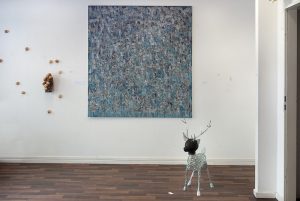
-
Animals as form
-
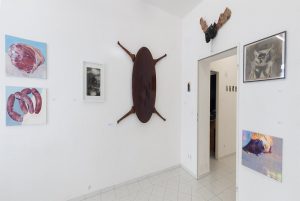
-
Cage of Preparation (l) | Enclosure of Humans Hunting other Animals (r)
-
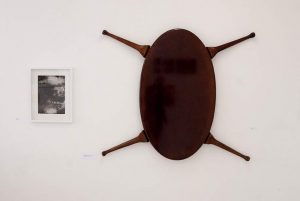
-
Enclosure of Humans Hunting other Animals
-
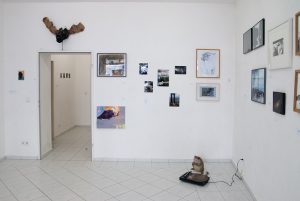
-
Compound of Friendship
-
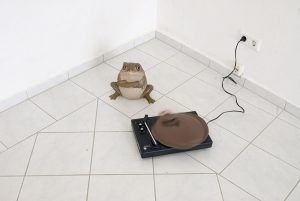
-
Enclosure of Identification of Humans with Other Animals
-
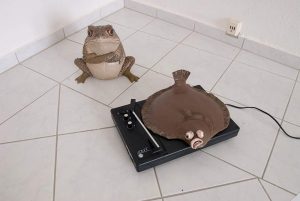
-
Enclosure of Identification of Humans with Other Animals
-
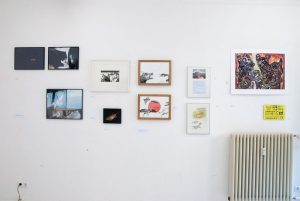
-
Compound of Chance Encounters (l) | Enclosure of Identification of Humans with Other Animals (r)
-
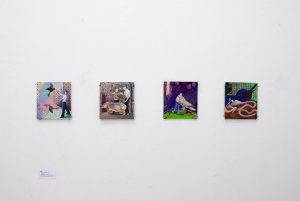
-
Dreamlike Encounters (Suspension of Hierarchies between
Humans and Other Animals)
-
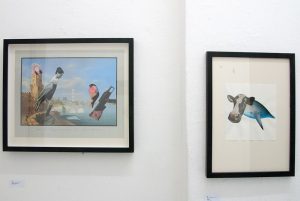
-
Dreamlike Encounters (Suspension of Hierarchies between
Humans and Other Animals)
-
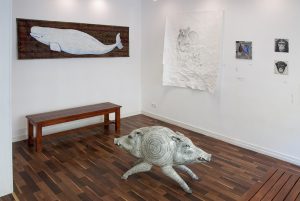
-
Enclosure of Humans Hunting other Animals | Homage to a Species
-
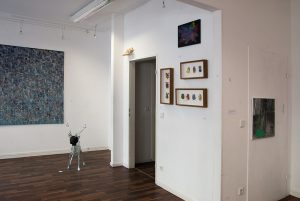
-
Compound of Taxonomies | Homage to a Species
-
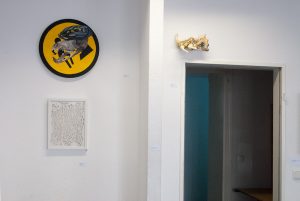
-
(l) Compound of Animals as Shapes in Art | (r) Homage to a Species
-
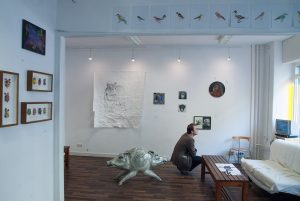
-
Front: Compound of Taxonomies | back (r): House of Relatives
-
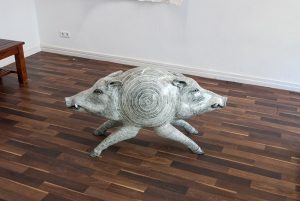
-
Enclosure of Humans Hunting other Animals
-
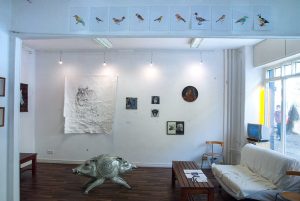
-
Exhibition view: madeinwedding
-
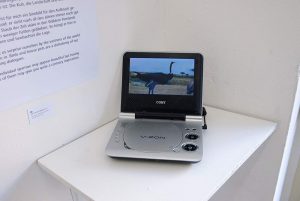
-
Compound of Chance Encounters
-
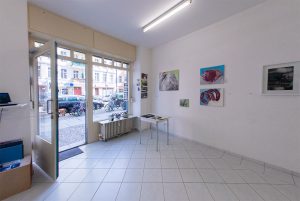
-
Cage of Preparation
-
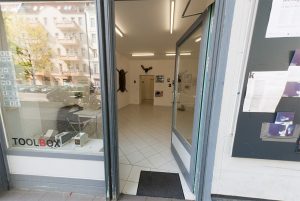
-
Exhibition view: Entrance Toolbox
Menagerie
Text: Anna E. Wilkens
„Menagerien“ waren höfische Tierparks (ca. 16.–18. Jh.), in denen Tiere aufgrund ihres Exotismus – analog den Kuriositätenkabinetts – gesammelt und „ausgestellt“ wurden. Sie gelten als Vorläufer des Zoos, dessen Erscheinen und Einrichtung auf zoologischen Taxonomien beruht, die im 18. Jahrhundert entwickelt wurden. Diese zoologischen Klassifizierungssysteme gehören zum modernen naturwissenschaftlichen Paradigma: Zoos sind ihrer Anlage nach in die Moderne gehörig, Menagerien sind vormodern.
Bis heute hat das Wort „Menagerie“ eine Bedeutungsverschiebung erfahren und meint eine ungeordnete Ansammlung, meist von Menschen, das Beispiel im Duden-online lautet „in übertragener Bedeutung: eine ganze Menagerie (scherzhaft; Ansammlung) von Künstlern war zugegen“.
Der Ausstellungstitel meint zum einen, dass die Ausstellung durch sowohl kuratorisches Konzept als auch Zufall entstanden ist – Ordnung/Intentionalität und Unordnung/Serendipity; zum anderen ist er als emphatischer Hinweis auf Historizität zu verstehen: die verschiedenen historischen Phasen im abendländischen menschlichen Diskurs über Tiere, besonders seit Beginn der Neuzeit.
Human Animal Studies: Animal Turn
Eine zunehmende Radikalisierung der Reflexion über die eigenen Vorannahmen, Vorurteile, den eigenen historischen Standpunkt zeichnet das (kulturwissenschaftliche) Reden über Tiere in den letzten etwa vier Jahrzehnten aus, noch verstärkt seit der Jahrtausendwende. Vorsichtig kann hier von einem Paradigmenwechsel (im Sinne Kuhns) gesprochen werden, eine Veränderung, die über einen „turn“ hinausgeht, der als ein Perspektivenwechsel innerhalb einer Disziplin bei gleichzeitiger Vernetzung mit anderen Disziplinen verstanden wird. Der Animal Turn (Harriet Ritvo) ist einer in einer ganzen Reihe von anderen zeitgenössischen Turns (cultural, spatial, corporeal, emotional, material, pictorial etc.). All diesen Turns gemein ist, so die These, dass ihre Grundlage die Loslösung von dem seit Descartes vorherrschenden erkenntnistheoretischen Paradigma ist, das auf Dichotomien beruht: res cogitans und res extensa, Geist und Körper, daran anhängend Kultur und Natur, Mensch und Tier, Mann und Frau, „und die entsprechend analogisch konstruierte Nähe von Kultur/Mensch/Mann versus Natur/Tier/Frau“, die „noch immer nicht vollends suspendiert“ ist (Carola Sachse).
Pluralität – Relationalität
Das neue Paradigma gründet in der Auffassung, dass Entitäten, welcher Art auch immer, nicht ohne ihre Beziehungen existieren. So bemerkt, zum Beispiel, Hannah Arendt, dass die Welt das „Zwischen“ sei und dass Menschen stets und immer schon im Plural existieren – und nicht, wie bei den deutschen Idealisten, als vervielfältigtes, immer gleich funktionierendes Subjekt. Eine solche Auffassung findet sich auch in der Transzendental- und Universalpragmatik (Habermas) sowie zeitgenössisch in Praxeologie, Actor Network Theory und Relationismus.
Agency: Tiere als Handelnde
Im Zuge der Betonung von Beziehungshaftigkeit allen Seins wird neuerdings Handlungsfähigkeit auch solchen Entitäten zuerkannt, die bisher stets als passive Objekte angesehen wurden: Tiere. Möglich ist das durch die Entkoppelung von Intentionalität und Handlungsfähigkeit, das heißt, man muss die Handlung nicht bewusst beabsichtigen, damit sie innerhalb einer Interaktion eine ist. Tiere sind zur Agency fähig, und in dieser haben verschiedenste Tiere die vielfältigsten Beziehungen zu Menschen. Oder: menschliche und andere Tiere interagieren miteinander.
Im überkommenen Weltbild war zunächst „der Mensch“ (im Singular, weil alle Exemplare als prinzipiell gleich gedacht wurden), dann hat „er“ (auf jeden Fall ist der exemplarische Mensch männlichen Geschlechts) Tiere domestiziert und sich die Welt untertan gemacht.
Dagegen setzt die Re-Interpretation historischer Mensch-Tier-Beziehungen mit der Menschwerdung an, indem zum Beispiel nicht mehr von der Domestizierung von Wölfen (die dann Hunde wurden) gesprochen wird, sondern von Allianzen zwischen Wölfen und Menschen, die entscheidend sind in der Menschwerdung, ohne die sie nicht oder ganz anders stattgefunden hätte. Das Gleiche gilt für Hunde, die ohne ihre Kooperation mit Menschen nicht wären oder ganz anders wären.
“Beings do not preexist their relatings.” (Donna Haraway)
Verschiedene mögliche Beziehungen zwischen Menschen und anderen Tieren sind Grundlage für die Gruppierungen der Werke in „Gehege“ im Ausstellungszoo:
Gehege der Freundschaften; Gehege der zufälligen Begegnungen; Hommage an eine Tiergattung; Taxonomien; Verwandtschafts-Haus; Identifikation von Menschen mit Tieren; Gehege der Präparation; Gehege der Jagd von Menschen auf andere Tiere; Tiere als Form (Selbstreflexion der Kunst); Traumhafte Begegnungen (Aufhebung der Hierarchie zwischen Menschen und anderen Tieren).
Ein paar Tiere haben ihre Gehege verlassen oder laufen als Wildtiere im Zoo herum.
Künstlerinnen und Künstler:
Aleksandar Jestrović, Berlin (Malerei)
Alexander Horn, Mannheim (Malerei)
Archi Galentz, Berlin (Zeichnung)
Buffy Klama Berlin (Zeichnung)
Carolina Brack, Berlin (Cutout)
Catherine Bourdon, Berlin (Malerei)
Christof Zwiener, Berlin (Video)
Dunja Hamdorf, Hamburg (Zeichnung)
Eike Laeuen, Berlin (Fotografie)
Erik Weiser, Leipzig (Skulptur)
Hannah Dougherty, Berlin (Zeichnung)
Heikki Länkinen, Finnland (Malerei)
Henrik Jacob, Berlin (Knete)
Ilia Kitup, Berlin (Zeichnung)
Ina Sangenstedt, Berlin (Skulptur)
Mr. Ira Schneider, Berlin (Video, Fotografie)
Jakob Roepke, Berlin (Malerei)
Johanna Lonka, Tampere FI (Installation)
Joseph Heeg, Mannheim (Malerei)
Jovan Balov, Berlin (Zeichnung, Foto)
Kaisu Koivisto, Helsinki (Skulptur)
Karen Koltermann, Berlin (Malerei, Video)
Katia Kelm Berlin, (Malerei, Installation)
Konstantin Voit, Mannheim (Malerei)
Laura Kärki, Helsinki (Skulptur)
Liisa Kanerva, Helsinki (Malerei)
Magdalena, Åberg Helsinki (Malerei)
Mika Karhu, Hyvinkää, FI (Zeichnung)
Nina Lassila, Belgien / Berlin (Video)
Otgonbayar Ershuu, Berlin (Malerei)
Reiner Maria Matysik, Berlin (Video, Aktion)
Ricarda Wallhäuser, Berlin (Collage)
Saana Inari, Berlin (Video)
Sampsa Indrén (Painting)
Sanni Seppä, Finnland (Zeichnung)
Sennf Berlin, (Mixed Media)
Skadi Engeln, Berlin (Druckgrafik)
Susanne Schirdewahn, Berlin (Skulptur)
Tanja Vetter, Mannheim (Malerei)
The Niñxs (Helena Hernández &
Rafael Koller), Berlin/Luzern (Zeichnung)
Tintin Patrone, Hamburg (Performance)
Veronika Witte, Berlin (Video)
Menagerie – Animals in the Art Zoo
Exhibition April 29—May 20, 2016
Finissage: 20.5. 2016 | 14-17.30 Uhr in both spaces, later only in Toolbox
Toolbox – Finnish-German Art Space, Koloniestraße 120, 13359 Berlin/Germany
On Bank Holidays Toolbox is closed
Curators: Anna E. Wilkens and Andreas Wolf with support from Karen Koltermann
In the exhibition, 43 artists take a variety of relations between animals, humans among them, into focus. These relations are, for example, love, prey, chance encounters, genetic hybridisation, classifying in zoological taxonomies, identifying, comparison (anthropomorphisms) and mystification.
Photos from the Opening
Menagerie
Text: Anna E. Wilkens
‘Menageries’ – courtly collections of animals (16th to 18th century), similar to Cabinets of Curiosity, in which animals were ‘displayed’ for reasons of being ‘exotic’ – are precursors to the modern zoo. The zoo, developed in the 19th century, relies on taxonomies that stem from the 18th century. These taxonomies are part of the modern scientific paradigm: zoos belong to modernity; menageries are pre-modern.
To the present day, the word ‘menagerie’ in German has undergone a shift of meaning, nowadays it signifies (in figurative use) a random and unsystematic collection of items or people. The example in the online edition of Duden, the German spelling authority for this usage is: ‘a whole menagerie of artists was present’.
The exhibition’s title points to the process of assembling the works: between curatorial concept and serendipity, and it furthermore emphatically stresses historicity: different historical stages in occidental human discourse on animals, especially post-medieval.
Human Animal Studies: Animal Turn
Reflection on prejudices and assumptions pertaining to one’s own historical standpoint have increased considerably in contemporary (cultural studies) discourse on animals in the last four decades, and even more so since the beginning of the 21st century.
Tentatively this can even be called a paradigm shift (according to Kuhn), a change in thought that goes beyond a turn; a turn being understood as a change of perspective in one academic discipline, while at the same time broadening the scope through working interdisciplinary. The Animal Turn is one in a whole menagerie of turns (linguistic, cultural, spatial, corporeal, emotional, material, iconic etc.). All of these share the common trait of liberating thought from the Cartesian epistemological paradigm that is based on dichotomies: res cogitans and res extensa, spirit and body, and based on this primary dichotomy there are culture and nature, human and animal, man and woman, and the analogously construed proximity of ‘culture/human/male versus nature/animal/woman, which still hasn’t been overcome completely’ (Carola Sachse).
Plurality – Relationality
The new paradigm holds that entities, of any kind, ‘do not pre-exist their relatings’ (Donna Haraway). For example Hannah Arendt states that the world we inhabit is in the ‘between’, that which exists between people (for Arendt always people, not animals), and that humans always and from the beginning have existed in the plural, as more than one – contrary to German philosophical Idealism, according to which each and every subject is basically the same (all individuals ‘function’ in the same way and therefore don’t exist in plurality, only in the plural).
The notion of world as plurality we find for example in Universal Pragmatism (Habermas), in Praxeology, Actor Network Theory and Relationalism. We are what we are in and through our relations with each other, animals included.
Agency: Animals as Acting Entities
Humans, in the course of emphasising relations as the cornerstone of all existence, recently began to acknowledge agency in beings formerly perceived as things or thing-like objects, not capable of acting. The possibility of perceiving animals as acting beings relies on a changed concept of action: action is no longer seen as being necessarily linked to intention, nor having an intention as prerequisite. Actions do not have to be conscious and purposeful to be called actions. So we can conceive of interactions as actions without these actions mandatorily being intentional. Animals are capable of agency and they have a whole lot of different relationships with humans (human animals). Or: humans and other animals interact.
In the traditional world view, first there was man (definitely in the singular, one man, since all specimen are basically the same), than ‘he’ (the exemplary human is always male) domesticated animals and subdued the world.
Contrary to this notion, the re-interpretation of historical relations between humans and other animals begins at the beginning of humanity; for example, dogs are no longer perceived as domesticated wolfs, but wolfs and early humans shaped alliances, cooperating in ways that were of fundamental importance for homo becoming human and wolf becoming dog. Without each other, they wouldn’t be what they are or they wouldn’t even be at all.
The works in the exhibition-zoo are grouped according to those relations of humans and other animals that we can see in them. The assemblages of works are called “compounds”, “enclosures”, “houses” etc., like in a zoo. There are of course more possible relations than are shown in the exhibition.
Compound of Friendship; Compound of Chance Encounters; Homage to a Species; Compound of Taxonomies; House of Relatives; Enclosure of Identification of Humans with Other Animals; Cage of Preparation; Enclosure of Humans Hunting other Animals; Compound of Animals as Shapes in Art; Dreamlike Encounters/Suspension of Hierarchies between Humans and Other Animals.
Some animals have left their compounds or are running around the zoo as strays or wild animals.
Aleksandar Jestrović Berlin (Painting)
Alexander Horn Mannheim (Painting)
Archi Galentz Berlin (Drawing)
Buffy Klama Berlin (Drawing)
Carolina Brack Berlin (Cutout)
Catherine Bourdon Berlin (Painting)
Christof Zwiener Berlin (Video)
Dunja Hamdorf Hamburg (Drawing)
Eike Laeuen Berlin (Photography)
Erik Weiser Leipzig (Sculpture)
Hannah Dougherty, Berlin (Drawing)
Heikki Länkinen, Finland (Painting)
Henrik Jacob, Berlin (Play Dough)
Ilia Kitup Berlin, (Drawing)
Ina Sangenstedt, Berlin (Sculpture)
Mr. Ira Schneider, Berlin (Video, Photography)
Jakob Roepke, Berlin (Painting)
Johanna Lonka, Tampere FI (Installation)
Joseph Heeg, Mannheim (Painting)
Jovan Balov, Berlin (Drawing, Photography)
Kaisu Koivisto, Helsinki (Sculpture)
Karen Koltermann, Berlin (Painting, Video)
Katia Kelm Berlin, (Sculpture, Painting)
Konstantin Voit, Mannheim (Painting)
Laura Kärki, Helsinki (Sculpture)
Liisa Kanerva, Helsinki (Painting)
Magdalena Åberg, Helsinki (Painting)
Mika Karhu, Hyvinkää, FI (Drawing)
Nina Lassila, Belgien / Berlin (Video)
Otgonbayar Ershuu, Berlin (Painting)
Reiner Maria Matysik Berlin (Video, Action Art)
Ricarda Wallhäuser Berlin (Collage)
Saana Inari Berlin (Video)
Sampsa Indrén (Painting)
Sanni Seppä Finland (Drawing)
Sennf Berlin (Mixed Media)
Skadi Engeln Berlin (Print)
Susanne Schirdewahn Berlin (Sculpture)
Tanja Vetter Mannheim (Painting)
The Niñxs (Helena Hernández &
Rafael Koller) Berlin/Lucerne (Drawing)
Tintin Patrone Hamburg (Performance)
Veronika Witte Berlin (Video)
Quotes from Artists | Zitate
Menschliche Porträts werfen immer auch Fragen nach der Person auf. „Wer ist diese Kröte genau und in welcher Beziehung stehen Sie zu Ihr?“ werde ich dagegen nur selten gefragt.
The deer has references to cute, big headed figures such as a Bambi. But on the other hand I want to confront the docile figure with the steel structure, which refers to machines and technology.
Ein erfreuliches Zeichen von Zivilisation sind Möwen wohl dann, wenn man in der Weite des Meeres in Seenot geraten ist. Bei ihrem Erscheinen kann man auf die Nähe eines Schiffes oder der Küste hoffen.
Warum diese Tiere? Weil sie gebündelt in einem gut postkartengroßen Schablonenheftchen aus den USA versammelt sind, zum Thema Reptilien.
Chester hatte ein Fell so schwarz wie die Nacht und einen Kopf, der war so breit, dass man ihn für einen Rammbock in Dackel-Gestalt halten konnte. Er hatte weder Manieren noch Freunde und verbrachte seine Tage dösend im Körbchen, das er nur verließ, um dann mit seinem irrsinnig breiten Schädel und mit Karacho einen seiner Hundekollegen umzuhauen.
In ihrer magischen Realität ist dieses Mischwesen aus Mensch und Tier die alles bestimmende Figur. Unter ihren Augen steigen Kugeln aus dem Wasser und Gewehre versinken darin.
Das Meerschweinchen hat weder etwas mit dem Meer zu tun, noch ist es mit dem Schwein verwandt. Eher unförmig und wenig elegant, hat es den einzigen Vorteil, wenn man den kulinarischen ausnimmt, als niedlich zu gelten und die volle Aufmerksamkeit von vorpubertierenden Mädchen für sich zu gewinnen.
Four bears are having a good time and drinking beer. It is a night when one of the bears is celebrating the birth of his child. The bear is like a totem animal for me. It is a very mythical animal here in Finland. There is also a very old myth of a woman and a bear having a love affair.
The motif (animal) in the picture is a small bird I found dead in my front yard. Probably killed by our cat.
Tiere und Menschen durchspielen als Protagonisten der fiktiven Szenenbilder psychische Realitäten und Einstellungen (attitudes) zur Wirklichkeit. Die Tiere sind dabei Verkörperungen von Affekten, sind rätselhafte Totems, erhabene Archetypen, deplazierte Störer und animalische Wiedergänger.
And if we aren’t eating it – then our pets are. Meat. Organized. Monetized. Industrialized.
In Verbindung mit Autos sind Insekten vor allem eines: lästig.
Max war mein Begleiter, mein Trabant und meine Muse. Er drang in meine Bilderwelt ein, auch in die Malerei und die Zeichnung. Durch ihn wusste ich: Alles ist Natur.
Wie schauen Affen fern? Welche Sendungen bevorzugen sie? Und wer bestimmt, was läuft? Solche Fragen mochte der Stuttgarter Zoo jetzt mit einer Forschungsreihe klären.
1977, I was in Kenya at the Masai Mara enormous animal free roaming preserve. On my way there at night I spotted an animal ahead in my headlights and quickly took a picture of this cheetah/Gepard. I continued on to my first night at the camping centre. Sleeping in a tent was difficult. I kept hearing lions roar behind it, nearby.
It was only in the light of morning that I saw that a large metal chain fence surrounded the entire camp.
I’d like to sing you a lullaby
about hedgehog
anteater and crayfish
and share my life with you
but you know I am just a dreamer
basically a small good-humored sculpture with big eyes, but the truth is that it has a high risk becoming extinct in the near future.
I was stressed and was told that I need to let go of control and swim around playfully, get my fish as the otter. The dove told me to slow down, pause and breathe – which felt quite stressful.
die einzigen tiere, die keine tiere sind, sind affen. und menschen sind keine menschen sondern tiere.
Die Wertfreiheit in ihrer Beobachtung ignoriert wiederkäuend meine Bemühungen, etwas besonders Anspruchvolles zu vollbringen und wirft mich immer wieder auf das zurück was ist: Die Kuh, die Landschaft und ich.
Der Kopf ist für mich ein Sinnbild für den Aufbruch geworden und: er sieht nach all den Jahren immer noch gut aus. Der Staub der Zeit wäre in den Wäldern Finnlands natürlich weniger haften geblieben. So hängt er hier in Berlin rum und beobachtet die Lage.
We let us surprise ourselves by the vastness of the world we live in. Birds and house pets are a dichotomy of our clashing dialogues.
An individual sparrow may appear beautiful but having tens of them may give you quite a contrary impression.
Photo bear: Mr. Ira Schneider
